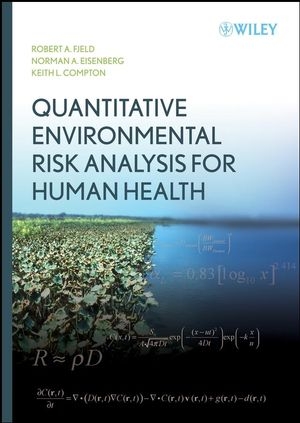
Quantitative Environmental Risk Analysis for Human Health
Wiley-Interscience (Verlag)
978-0-471-72243-4 (ISBN)
- Titel erscheint in neuer Auflage
- Artikel merken
A COMPREHENSIVE TEXTBOOK AND REFERENCE FOR QUANTITATIVE ENVIRONMENTAL RISK ANALYSIS FOR BOTH CHEMICAL AND RADIOACTIVE CONTAMINANTS Environmental risk analysis is complex and interdisciplinary; this book explains the fundamental concepts and analytical methods in each essential discipline. With an emphasis on concepts and applications of quantitative tools plus coverage of analysis of both chemical and radioactive contaminants, this is a comprehensive resource.
After an introduction and an overview of the basics of environmental modeling, the book covers key elements in environmental risk analysis methodology, including:
Release assessment and source characterization
Migration of contaminants in various media, including surface water, groundwater, the atmosphere, and the food chain
Exposure assessment
Basic human toxicology and dose-response
Risk characterization, including dose-response modeling and analysis
Risk management process and methods
Risk communication and public participation
This reference also relates risk analysis to current environmental laws and regulations. An ideal textbook for graduate students and upper-level undergraduates in various engineering and quantitative science disciplines, especially civil and environmental engineering, it is also a great reference for practitioners in industry, environmental consulting firms, and regulatory agencies.
ROBERT A. FJELD, PhD, is the Dempsey Professor of Waste Management, Department of Environmental Engineering and Science, at Clemson University. He was among the first to develop curriculum covering quantitative human health risk assessment for both chemical and radiological contaminants. NORMAN A. EISENBERG, PhD, has over thirty years of experience in environmental risk analysis, including work on environmental analysis within the federal government (U.S. Nuclear Regulatory Commission and Department of Energy) and as a consultant, and teaching graduate environmental courses at the University of Maryland. KEITH L. COMPTON, PhD, is a systems performance analyst in the Division of Waste Management at the U.S. Nuclear Regulatory Commission.
Preface. 1 Introduction.
1.1 Risk Analysis.
1.2 Risk.
1.3 Contaminants in the Environment.
1.4 Uses of Environmental Risk Assessment.
1.5 Risk Assessment Process.
References.
Additional Reading.
Problems.
2 Fundamental Aspects of Environmental Modeling.
2.1 Introduction.
2.2 Modeling Process.
2.3 Physical and Mathematical Basis for Risk Assessment Models.
2.4 Contaminant Transport Equation.
References.
Problems.
3 Release Assessment.
3.1 Introduction.
3.2 Conceptual Model.
3.3 Contaminant Identification.
3.4 Emission-Rate Quantification.
References.
Additional Reading.
Problems.
4 Environmental Transport Theory.
4.1 Introduction.
4.2 One-Dimensional Solutions of the Contaminant Transport Equation.
4.3 Three-Dimensional Contaminant Transport.
4.4 Advanced Solution Methods.
References.
Additional Reading.
Problems.
5.1 Introduction.
5.2 Types of Surface Water Bodies.
5.3 Sorption.
5.4 Transport Modeling.
References.
Additional Reading.
Problems.
6 Groundwater Transport.
6.1 Introduction.
6.2 Subsurface Characterization.
6.3 Saturated Flow in Porous Media.
6.4 Sorption.
6.5 Subsurface Contaminant Transport Modeling.
6.6 Other Considerations in Groundwater Transport.
References.
Additional Reading.
Problems.
7 Atmospheric Transport.
7.1 Introduction.
7.2 Atmospheric Dispersion.
7.3 Atmospheric Transport Models.
7.4 Other Considerations.
References.
Additional Reading.
Problems.
8 Food Chain Transport.
8.1 Introduction.
8.2 Concentration in Soil.
8.3 Concentration in Vegetation.
8.4 Concentration in Animals.
References.
Problems.
9 Exposure Assessment.
9.1 Introduction.
9.2 Dose.
9.3 Contaminant Intake.
9.4 Dose Calculations.
References.
Problems.
10 Basic Human Toxicology.
10.1 Introduction.
10.2 Fundamentals of Anatomy and Physiology.
10.3 Mechanisms and Effects of Toxicity.
References.
Additional Reading.
Problems.
11 Dose–Response and Risk Characterization.
11.1 Introduction.
11.2 Biological Basis of Dose–Response Modeling.
11.3 Elements of Quantitative Dose–Response Analysis.
11.4 Dose–Response Modeling.
11.5 Risk Characterization.
11.6 Regulatory Implementation.
References.
Additional Reading.
Problems.
12 Uncertainty and Sensitivity Analyses.
12.1 Introduction.
12.2 Types and Sources of Uncertainty.
12.3 Statistical Fundamentals.
12.4 Uncertainty Propagation.
References.
Problems.
13 Stakeholder Involvement and Risk Communication.
13.1 Introduction.
13.2 Stakeholder Involvement.
13.3 Risk Communication.
References.
Problems.
14 Environmental Risk Management.
14.1 Introduction.
14.2 Risk Management Process.
14.3 Risk Management Methods.
References.
Problems.
15 Environmental Laws and Regulations.
15.1 Introduction.
15.2 General Legal and Regulatory Structure for Environmental Protection.
15.3 Major Federal Environmental Laws and Regulations.
15.4 CERCLA Process.
15.5 Additional Regulations.
References.
Problems.
Appendix A Mathematical Tools.
A.1 Special Functions.
A.2 Laplace Transforms.
References.
Additional Reading.
Appendix B Degradation and Decay Parameters.
Index.
| Erscheint lt. Verlag | 16.2.2007 |
|---|---|
| Sprache | englisch |
| Maße | 185 x 255 mm |
| Gewicht | 837 g |
| Themenwelt | Studium ► Querschnittsbereiche ► Prävention / Gesundheitsförderung |
| Naturwissenschaften ► Chemie | |
| ISBN-10 | 0-471-72243-X / 047172243X |
| ISBN-13 | 978-0-471-72243-4 / 9780471722434 |
| Zustand | Neuware |
| Informationen gemäß Produktsicherheitsverordnung (GPSR) | |
| Haben Sie eine Frage zum Produkt? |
aus dem Bereich



